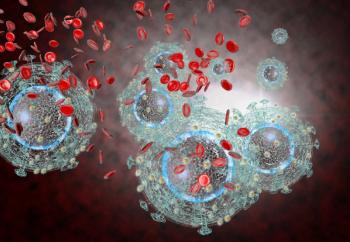
Procalcitonin Aids Sepsis Assessment
HOMBURG, Germany -- There is a quick, reliable way to assess sepsis and overall prognosis in secondary peritonitis, according to researchers here.
HOMBURG, Germany, Feb. 23 -- The goal may be closer to finding a quick, reliable way to assess sepsis and overall prognosis in secondary peritonitis, according to researchers here.
"There is major interest in the search for an optimum diagnostic tool for an early, noninvasive and reliable diagnosis of abdominal infections and sepsis," said Bettina Rau, M.D., of the University of the Saarland, and colleagues.
The current use of imaging procedures, such as computed tomography, and guided aspiration techniques to diagnose septic abdominal complications can be difficult and may have the potential for complications, the German group said.
"An accurate and readily available biochemical marker for identifying patients at risk for abdominal infections would definitely contribute to easier and safer diagnosis," the researchers said.
Concentrations of the compound procalcitonin -- the inactive precursor of the hormone calcitonin -- are closely correlated with the development of septic multiorgan dysfunction syndrome, Dr. Rau and colleagues found.
Peak levels of the compound occur shortly after symptom onset or soon after surgery, they reported in the February issue of Archives of Surgery.
At the same time, levels of C-reactive protein, a routinely used laboratory marker, showed no such correlation, the researchers reported.
Secondary peritonitis must generally be treated surgically, Dr. Rau and colleagues noted, but continuing or new-onset abdominal sepsis is a major problem following surgery.
Procalcitonin is known to correlate closely with the inflammatory host response to microbial infections, so the researchers initiated a multi-center cohort study to examine how it could be used to assess sepsis.
In 82 peritonitis patients at five European centers, the compound was measured prospectively using a semi-automated system manufactured by Brahms Diagnostica AG, of Henningsdorf, Germany. The company supported the study.
The analysis found:
- Nine of the patients died, eight because of multiorgan dysfunction syndrome and one from a myocardial infarction.
- 42 patients developed lung failure, 25 developed kidney failure, 35 had multiorgan dysfunction syndrome and, of those, 31 cases were septic and three sterile.
- Procalcitonin concentrations were significantly elevated (at P<0.05) during the immediate post-operative course in patients with septic multiorgan dysfunction syndrome.
- A persistently high concentration of procalcitonin after the first week -- greater than 1bng/mL -- was seen in the non-survivors.
Analysis using receiver operating characteristic curves showed that procalcitonin was closely correlated with septic multiorgan dysfunction syndrome -- the area under the curve was 0.84 with a 95% confidence interval from 0.77 to 0.89.
The compound was also correlated with persisting abdominal sepsis (the area under the curve was 0.76 with a 95% confidence interval from 0.69 to 0.82) and with nonsurvival (the area under the curve was 0.73 with a 95% confidence interval from 0.66 to 0.80).
On the other hand, no correlations were seen with CRP, the researchers said.
"In contrast to CRP, maximum procalcitonin levels were significantly higher in patients with peritonitis who developed septic multiorgan dysfunction syndrome, experienced persisting abdominal sepsis despite surgical treatment, or subsequently died," they said. The differences were significant at P<0.001.
Because the turn-around time for the test is about 30 minutes, using the Brahms equipment, "procalcitonin meets the demands of a readily available biochemical marker under clinical routine and emergency conditions," Dr. Rau and colleagues concluded.
Newsletter
Enhance your clinical practice with the Patient Care newsletter, offering the latest evidence-based guidelines, diagnostic insights, and treatment strategies for primary care physicians.



















































































































































































































































































